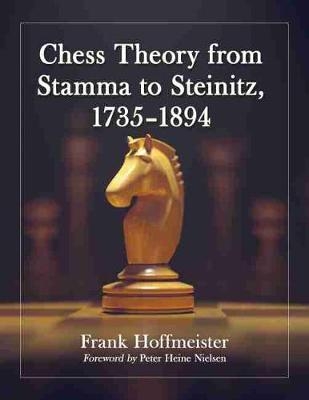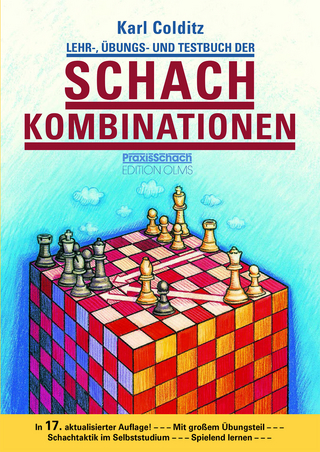
Chess Theory from Stamma to Steinitz, 1735-1894
McFarland & Co Inc (Verlag)
978-1-4766-8071-2 (ISBN)
Most chess biographies present the games of famous players--but not their writings. Filling that gap, this book begins with Syrian master and author of chess studies Philip Stamma, and finishes with the first world champion William Steinitz. The main novelties in opening, middlegame and endgame theory in the 160 year period are examined and biographical sketches put the contributions of more than 30 masters into context.
The author presents many new insights--for example, regarding the origins of the Ponziani Opening, the Dutch Defense and the Petroff Defense. French star La Bourdonnais used other sources for almost every part of his Nouveau Traite. Morphy's analysis of the Philidor Defense was faulty and Anderssen's play included many positional ideas. Harrwitz and Neumann published modern treatises long before Steinitz came out with his Modern Chess Instructor. Many ending themes belong to less well-known authors, such as Cozio, Chapais, van Zuylen van Nyevelt, Sarratt, Kling and Horwitz, Berger and Salvio.
A European Union official and professor of international economic law, Frank Hoffmeister was several times finalist of the German amateur chess championship. Between 2009 and 2020 he served as president of Europchess, the club of the European institutions in Brussels, and published several reviews of chess history books in the journal Schach. He lives in Kraainem, Belgium.
Table of Contents
Acknowledgments
Abbreviations Used in This Book
List of Game and Puzzle DIAGRAM Numbers
Foreword by Peter Heine Nielsen
Introduction
I. From Bertin to Del Rio (1735–1775)
A. The Time
Old Arab Puzzles and New Opening Ideas
Philidor Versus the Italian School
B. The Players
Joseph Bertin (ca. 1690–1736)
Philip Stamma (ca. 1700–1755)
Carlo Francesco Cozio (ca. 1715–ca. 1780)
François-André Danican Philidor (1726–1795)
Giambattista Lolli (1698–1769), Domenico Ponziani (1719–1795) and Ercole del Rio (1718–1802)
C. The Legacy
II. From Allgaier to McDonnell (1775–1835)
A. The Time
The French Amateurs and Their Traité
Elias Stein (1748–1812) and His Nouvel Essai
Philip Julius Count van Zuylen van Nijevelt (1743–1826) and His Superiorité aux Echecs
The Chess Automaton
Clément Felix Brossier Montigny (1786–1840) and His Stratagèmes des Echecs
Jacob Henry Sarratt (ca. 1772–1819) and His Treatise
Alexandre Louis Honoré Lebreton Deschappelles (1780–1846) and His 1821 Matches
John Cochrane (1798–1878) and His Treatise on the Game of Chess
The Friendly Match Between Lewis and La Bourdonnais
The 1834 Match Between La Bourdonnais and McDonnell in London
B. The Players
Johann Baptist Allgaier (1763–1823)
William Lewis (1787–1870)
Louis Charles Mahé de La Bourdonnais (1797–1840)
Alexander McDonnell (1798–1835)
C. The Legacy
III. From Petroff to Staunton (1835–1850)
A. The Time
The Unsuccesful Challenge from Deschapelles to England 1836
Aaron Alexandre (1766–1850) and His Encyclopedia
George Walker (1809–1879) and His New Treatise on Chess
The 1843 Match Between Saint-Amant and Staunton in Paris
Lionel Adalbert Bagration Felix Kieseritzky (1806–1853) and His Gambit
The Development of Chess in Italy
The Development of Chess in Germany
The Development of Chess in the Austrian Empire
The Development of Chess in Russia
B. The Players
Alexander Dmitrievich Petroff (1794–1867) and Carl Ferdinand von Jaenisch (1813–1872)
Tassilo von Heydebrand und der Lasa (1818–1890)
Pierre Charles Fournier de Saint-Amant (1800–1872)
Howard Staunton (1810–1874)
C. The Legacy
IV. From Anderssen to Morphy (1851–1859)
A. The Time
London 1851
The Chess Studies from Josef Kling (1811–1876) and Bernhard Horwitz (1807–1885)
The First Indian Openings
The 1853 Match Between Löwenthal and Harrwitz in London
Max Lange (1832–1899) and His Attack
Manchester 1857
New York 1857
The 1858 Match Between Löwenthal and Morphy in London
John Owen (1827–1901) and His Defense
Birmingham 1858
The 1858 Match Between Morphy and Harrwitz in Paris
The 1858-1859 Match Between Morphy and Anderssen in Paris
B. The Players
Karl Ernst Adolf Anderssen (1818–1879)
Daniel Harrwitz (1821–1884)
Johann Jacob Löwenthal (1806–1874)
Paul Charles Morphy (1834–1884)
C. The Legacy
V. From Paulsen to Neumann (1860–1871)
A. The Time
The 1860 Match Between Kolisch and Anderssen in Paris
The 1861 Match Between Kolisch and Anderssen in London
Bristol 1861
The 1861 Match Between Kolisch and Paulsen in London
London 1862
Serafino Dubois (1817–1899) and His Defense of Italian Chess Rules
The 1862 Match Between Paulsen and Anderssen in London
Jean Louis Préti (1798–1881) and His Stratégie Raisonnée des Ouvertures
Robert Bownas Wormald (1834–1876) and His Chess Openings
The 1866 Match Between Anderssen and Steinitz in London
Paris 1867
Dundee 1867
Baden-Baden 1870
B. The Players
Louis Paulsen (1833–1891)
Ignaz Kolisch (1833–1889)
Gustav Richard Ludwig Neumann (1838–1881)
C. The Legacy
VI. From Rosenthal to Zukertort (1872–1885)
A. The Time
London 1872
The 1872 Match Between Steinitz and Zukertort in London
Vienna 1873
William Cook (1850–1917) and His Synopsis of Chess Openings
The 1876 Match Between Steinitz and Blackburne in London
Leipzig 1877
Paris 1878
The 1880 Match Between Zukertort and Rosenthal in London
Wiesbaden 1880
The 1881 Match Between Zukertort and Blackburne in London
Berlin 1881
Vienna 1882
London 1883
Nuremburg 1883
Hamburg 1885
Horatio Caro (1862–1920) and His Defense
Carlo Salvioli (1848–1930) and His Teoria e Pratica degli Scacchi
B. The Players
Samuel Rosenthal (1837–1902)
Szymon Abramowicz Winawer (1838–1919)
Joseph Henry Blackburne (1841–1924)
Johannes Zukertort (1842–1888)
C. The Legacy
VII. From Steinitz to Chigorin (1886–1894)
A. The Time
The 1886 World Championship Match Between Steinitz and Zukertort in the United States
London 1886
George Henry Mackenzie (1837–1891) and His Triumph at Frankfurt 1887
The 1889 World Championship Match Between Steinitz and Chigorin in Havana
New York 1889
Breslau 1889
Amsterdam 1889
The Chess Openings Ancient and Modern from Edward Freeborough (1830–1896) and Charles Ranken (1828–1905)
Johann Nepomuk Berger (1845–1933) and His Theorie and Praxis der Endspiele
The 1890 Match Between Chigorin and Gunsberg in Havana
Manchester 1890
The 1890-1891 World Championship Match Between Steinitz and Gunsberg in New York
The 1892 World Championship Match Between Steinitz and Chigorin in Havana
The 1892 Match Between Blackburne and Lasker in London
Dresden 1892
The 1893 Match Between Tarrasch and Chigorin in St. Petersburg
Curt von Bardeleben (1861–1924) and His Wiener Partie
The 1894 World Championship Match Between Steinitz and Lasker in the United States
James Mason (1849–1905) and His Principles of Chess
Henry Edward Bird (1829–1908) and His Chess Novelties
B. The Players
Wilhelm Steinitz (1836–1900)
Isidor Arthur Gunsberg (1854–1930)
Amos Burn (1848–1925)
Mikhail Ivanovich Chigorin (1850–1908)
C. The Legacy
VIII. Conclusion
Theory and Practice
Openings
Middlegame
Endings
Blindfold Chess, Chess Composition and Odds Games
Chess Personalities
Presentation of Chess Games
Chess Nations
Appendices:
1: Overlap of Puzzles Between Bertin, Stamma, Cozio and Lolli
2: Overlap of Puzzles Between Montigny and Others
3: Overlap of Puzzles Between Allgaier’s Neue theoretische Anweisung and Others
4: Overlap of Puzzles Between La Bourdonnais and Others
5: Overlap of La Bourdonnais’ Nouveau Traité with Montigny’s Cleveland Manuscripts
6: Overlap of Endings Between La Bourdonnais’ Nouveau Traité, Philidor’s Analyse and the Traité des Amateurs
7: Overlap of Puzzles Between Petroff and Others
8: Milestones of Algebraic Notation in the 19th century
9: The Use of First Names and the Spelling of Family Names
Bibliography
Openings Index (to Diagram Numbers)
General Index (to Page Numbers)
| Erscheinungsdatum | 04.01.2022 |
|---|---|
| Zusatzinfo | 83 illustrations, 407 diagrams, appendices, bibliography, index |
| Verlagsort | Jefferson, NC |
| Sprache | englisch |
| Maße | 216 x 279 mm |
| Gewicht | 1129 g |
| Themenwelt | Sachbuch/Ratgeber ► Freizeit / Hobby ► Spielen / Raten |
| ISBN-10 | 1-4766-8071-X / 147668071X |
| ISBN-13 | 978-1-4766-8071-2 / 9781476680712 |
| Zustand | Neuware |
| Haben Sie eine Frage zum Produkt? |
aus dem Bereich


